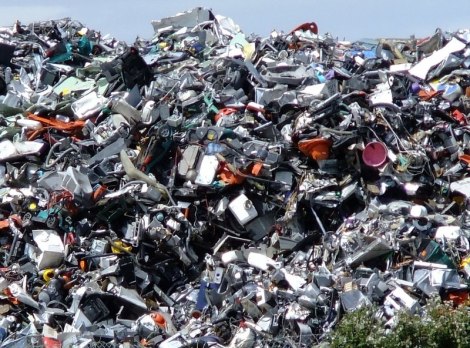ENVIRONMENT
How does e-waste contribute to pollution?
Teachers, scroll down for a quick list of key resources in our Teachers Toolkit.

Photograph by Stefan Czapski, courtesy Geograph. CC-BY-SA-2.0
Discussion Ideas
- A new study documents the skyrocketing accumulation of e-waste in East Asia. What is e-waste?
- E-waste, short for electronic waste, simply describes any electronic devices or their parts that have been thrown away. (Sometimes, e-waste is called ewaste or EEE waste. EEE is an acronym for electrical and electronic equipment.)
- Some examples of e-waste include computers, tablets, televisions, cell phones, VCRs, stereos, copiers, scanners, mouses, keyboards, and microwave ovens.
- Why is e-waste such a concern?
- When not recycled or disposed of properly, e-waste is often burned or washed in acids to extract minute amounts of gold, silver, palladium, copper, or other precious metals and minerals. These “acid baths” can pollute water and air, and “[a]ssociations have been reported between exposure from improper treatment of e-waste and altered thyroid function, reduced lung function, negative birth outcomes, reduced childhood growth, negative mental health outcomes, impaired cognitive development, cytotoxicity, and genotoxicity.”
- E-waste represents 2% of America’s trash in landfills, but about 70% of toxic waste.

- The study researched e-waste in “East and Southeast Asia.” What countries were included in the study?
- Cambodia
- China
- Hong Kong
- Indonesia
- Japan
- Malaysia
- Philippines
- Singapore
- South Korea
- Taiwan
- Thailand
- Vietnam
- Of the countries studied, Hong Kong, Singapore, and Taiwan had the highest rates of e-waste generation.
- Of the countries studied, Japan, South Korea, and Taiwan had the most comprehensive and efficient e-waste recycling and disposal policies.
- Why is the amount of e-waste increasing not only in East Asia, but around the world?
- Increased production. More and more established companies and start-ups are investing in hardware as well as software. Portable technology, such as smart watches, showed the biggest increase in e-waste.
- Gadget turnover. Gadgets, from cell phones to TVs, are becoming outdated more and more quickly. There are three reasons for this.
- Advancing technology makes older products obsolete due to hardware incompatibility. Examples of this include flash drives replacing floppy disks and streaming platforms replacing DVDs or CDs.
- Advancing technology makes older products obsolete due to software incompatibility. The key example of this is the minimum requirements for computers to run operating software.
- Products simply go out of fashion. Cutting-edge devices are being phased out in a matter of months.
- Larger middle class in East Asia. The economies of East Asia are growing rapidly. More and more people are able to afford electronic gadgets, and afford to replace them when they become outdated.
- Imported used goods. Import of used electronics increases the accumulation of e-waste in East Asia and other industrializing and developing regions.
- Imported waste. A large amount of e-waste from the Western world (which produces four times the e-waste per capita as East Asia) is exported to poorer countries, adding to their domestic waste.
- Although nearly every piece of an electronic device can be recycled, very few consumers, dismantlers, and recyclers actually do so. Why?
- Little incentive to recycle. “From a technological point of view, you could recycle 99% of e-waste, but it’s not economical,” says the lead social scientist involved in the study. “We need to design incentives to encourage a circular economy.”
- Lack of awareness. Often, both end-users and informal e-waste recyclers are unaware of the health and environmental risks associated with e-waste.
- Lack of convenience. Many e-waste recyclers are too expensive for end-users, and many regions do not have well-distributed disposal sites where consumers can easily drop off their waste.
- Lack of appropriate disposal facilities. Many regions lack the oversight, engineering, and architecture required to dispose of hazardous waste.
- Lack of enforcement. Many regions do not have government or law-enforcement personnel that prioritize environmental compliance.
TEACHERS TOOLKIT
EurekAlert!: E-waste in East and Southeast Asia jumps 63 percent in 5 years
Nat Geo: What is pollution?
Nat Geo: Hazardous Waste photo
extra credit! United Nations University: Regional E-Waste Monitor—East and Southeast Asia


Thanks for sharing the valuable information,This is useful information for online learners.
disposal of electronic waste.